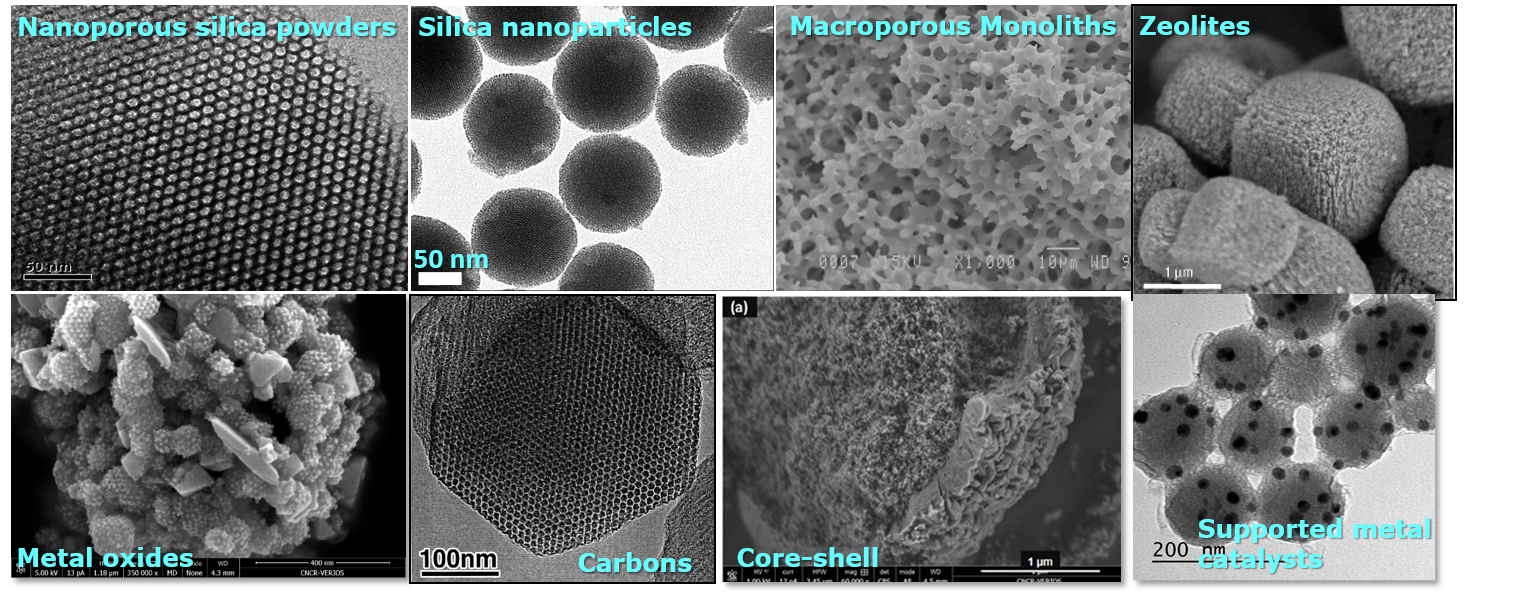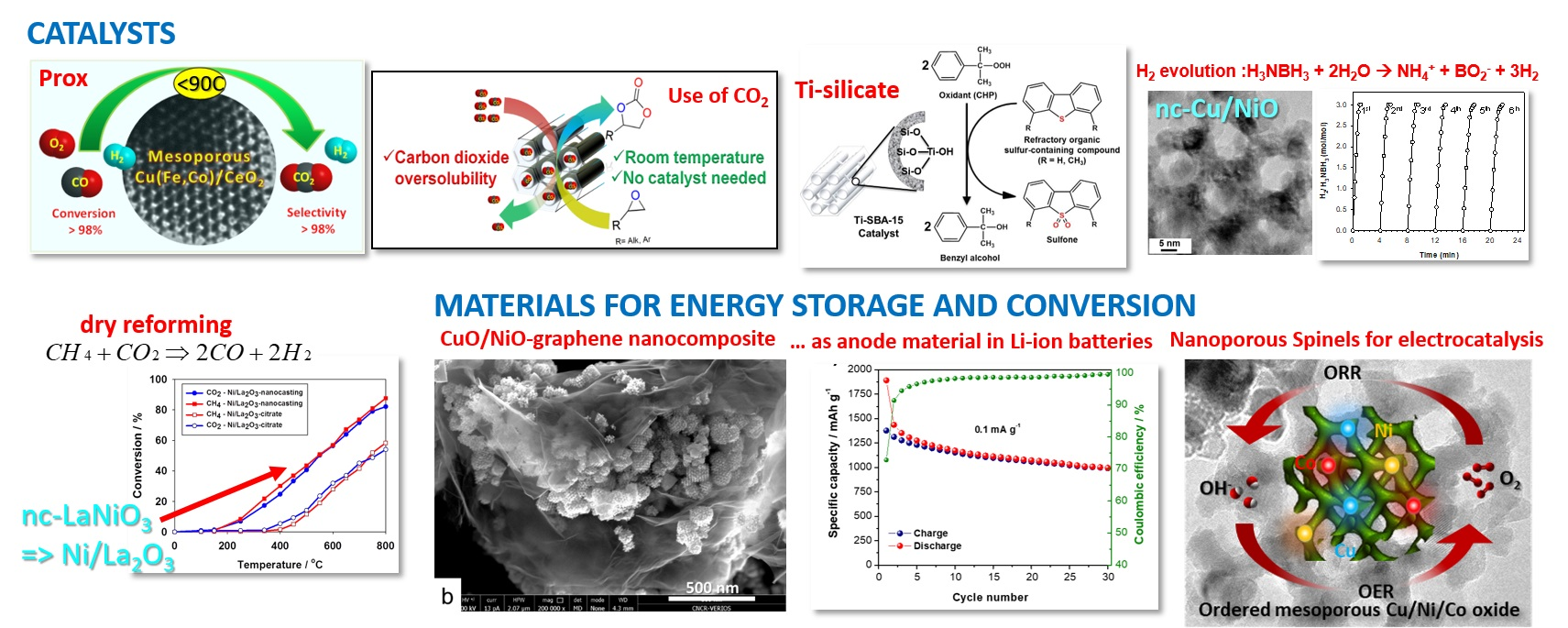The research work of AG Kleitz
Since 2016, Freddy Kleitz has established in the Faculty of Chemistry a brand-new laboratory infrastructure dedicated to the development of nanoporous materials, their characterization and their applications. In the laboratory of Prof. Kleitz, the researchers have access to state-of-the-art analytic techniques for the characterization of such porous solids, including gas adsorption measurements for specific surface area, pore volume, and pore size distribution. Furthermore, the Kleitz team has access to methods for the characterization of the materials structures, compositions and functionalities.
Our research activities concentrate mainly on the development of functional materials exhibiting well-defined pores in a range of size below 100 nm, i.e. nanoporous materials, and the study of their physicochemical properties and potential applications.
Over the years, the Kleitz team has developed a strong expertise in the synthesis and functionalization of microporous and mesoporous inorganic materials. This includes the synthesis and characterization of nanoporous oxides and silicates obtained via templating methods.
The research also emphasizes the design of hybrid materials by selective positioning of guest species (organics, polymers, inorganic clusters, nanoparticles, biomolecules, etc.) in specific sites inside inorganic matrices. Furthermore, part of the research is dedicated to the preparation of inorganic-organic hybrids through (bio)chemical functionalization strategies.
Type of materials:
- Porous materials (nanoporous) / Templating strategies / Sol-gel / Hydrothermal synthesis
- Silica and silicates (incl. zeolites) / Metal oxides /Organic-inorganic hybrids / Carbons / Porous Silicon
- Powders / Nanoparticles / Colloids / Monoliths

Recent References
- von Baeckmann, C.; Rubio, G. M. D. M.; Kählig, H.; Kurzbach, D.; Reithofer, M.R.; Kleitz, F., “Evaporation-Induced Self-Assembly of Small Peptide-Conjugated Silica Nanoparticles”, Angew. Chem. Int. Ed. 2021, 60, 22700-22705. DOI: 10.1002/anie.202108378.
- von Baeckmann, C.; Eisen, C.; Kählig, H.; Guggenberger, P.; Kleitz, F., “Facile Synthesis of Spatially‐Functionalized Core‐Shell Nanocatalysts with 3‐D Mesopore Structure”, ChemCatChem 2021, 13, 1140-1145. DOI:10.1002/cctc.202001737.
- von Baeckmann, C.; Kählig, H.; Lindén, M.; Kleitz, F.*, “On the importance of the linking chemistry for the PEGylation of mesoporous silica nanoparticles”, J. Colloid Interf. Sci. 2021, 589, 453-461. DOI:10.1016/j.jcis.2020.12.004.
- Guillet-Nicolas, R.; Wainer, M.; Marcoux, L.; Thommes, M.; Kleitz, F., “Exploring the confinement of polymer nanolayers into ordered mesoporous silica using advanced gas physisorption”, J. Colloid Interf. Sci. 2020, 579, 489-507. DOI:10.1016/j.jcis.2020.05.103.
- Masoumifard, N.; Guillet-Nicolas, R.; Kleitz, F.*, “Synthesis of Engineered Zeolitic Materials: From Classical Zeolites to Hierarchical Core–Shell Materials”, Adv. Mater. 2018, 30, 1704439. DOI: 10.1002/adma.201704439.
Our objective is to design high-surface-area materials incorporating functional groups and having suitable particle morphologies for selective sorption and separation applications (e.g., pollutant removal, extraction chromatography, water treatment), heterogeneous catalysis (e.g., sustainable chemical and fuel production, electrocatalysis, H2 production), and biomedical applications (e.g., drug delivery, vectorization). Inorganic porous structures are also synthesized to serve as host or template for the preparation of nanostructured objects (metal or metal oxide nanoparticles, nanowires, non-siliceous networks). In addition to technological aspects, the research provides fundamental understanding of host-guest interactions within nanopores, adsorption processes, confinement effects, interfacial interactions and transport phenomena at the nanoscale.
Applications:
- Sorbents (gas adsorption, liquid adsorption)
- Extraction materials for critical metals recovery
- Solid catalysts and catalyst supports (Lewis acid catalysis, base catalysis, oxidation, dry reforming, hydrogen evolution, green chemistry, use of CO2)
- Electrocatalysts and active materials for electrodes (Li-ion batteries, Si electrodes, fuel cells, metal-air batteries)
- Nanocarriers (drug delivery)

Recent References
- Priamushko, T.; Guillet-Nicolas, R.; Yu, M.; Doyle, M.; Weidenthaler, C.; Tüysüz, H.; Kleitz, F., “Nanocast Mixed Ni-Co-Mn Oxides with Controlled Surface and Pore Structure for Electrochemical Oxygen Evolution Reaction”, ACS Applied Energy Mater. 2020, 3, 5597-5609. DOI: 10.1021/acsaem.0c00544
- Juère, E.; Caillard, R.; Marko, D.; Del Favero, D.; Kleitz, F., “Smart Protein‐Based Formulation of Dendritic Mesoporous Silica Nanoparticles: Toward Oral Delivery of Insulin”, Chem. Eur. J. 2020, 26, 5195-5199. DOI: 10.1002/chem.202000773.
- Hu, Y.; Florek, J.; Larivière, D.; Fontaine, F.-G.; Kleitz, F., “Recent Advances in the Separation of Rare Earth Elements Using Mesoporous Hybrid Materials”, The Chemical Record 2018, 18, 1261–1276.DOI:10.1002/tcr.201800012.
- Lefrancois Perreault, L.; Colo, F.; Meligrana, G.; Kim, K.; Fiorilli, S.; Bella, F.; Nair, J.R.; Vitale-Brovarone, C.; Florek, J.; Kleitz, F.; Gerbaldi, C., “Spray-Dried Mesoporous Mixed Cu-Ni Oxide@Graphene Nanocomposite Microspheres for High Power and Durable Li-Ion Battery Anodes”, Adv. Energy Mater. 2018, 8, 1802438. DOI:10.1002/aenm.201802438. (Front Cover).
- Xu, W.; Ollevier, T.; Kleitz, F., “Iron-modified mesoporous silica as an efficient solid Lewis acid catalyst for the Mukaiyama aldol reaction”, ACS Catalysis 2018, 8, 1932-1944. DOI: 10.1021/acscatal.7b03485.
- Yen, H.; Seo, Y., Kaliaguine, S.; Kleitz, F., “Role of Metal-Support Interactions, Particle size, and Metal-Metal Synergy in CuNi Nanocatalysts for H2 Generation”, ACS Catalysis 2015, 5, 5505-5511. DOI: 10.1021/acscatal.5b00869.
- Nair, M. M.; Kaliaguine, S.; Kleitz, F., “Nanocast LaNiO3 Perovskites as Precursors for the Preparation of Coke-Resistant Dry Reforming Catalysts”, ACS Catalysis 2014, 4, 3837-3846. DOI: 10.1021/cs500918c.
- Yen, H.; Seo, Y.; Kaliaguine, S.; Kleitz, F., “Tailored Mesostructured Copper-Ceria Catalysts with Enhanced Performance for Low-Temperature Preferential Oxidation of CO (PROX)”, Angew. Chem. Int. Ed. 2012, 51, 12032-12035. DOI: 10.1002/anie.201206505.
